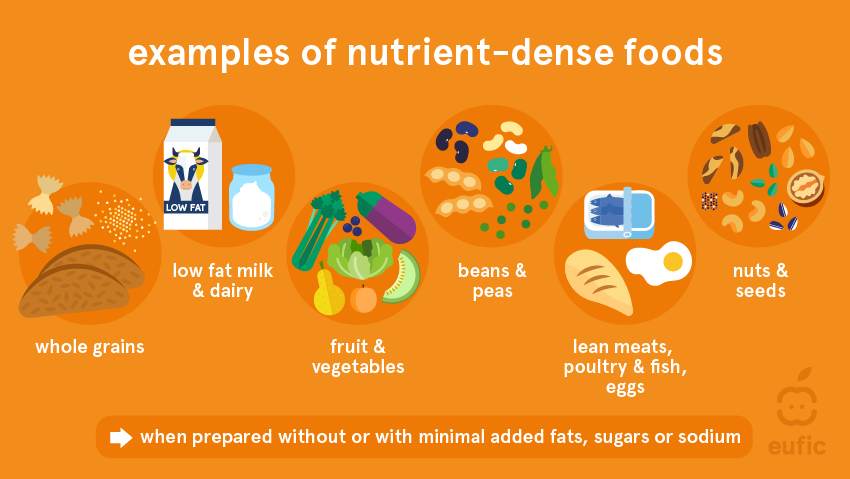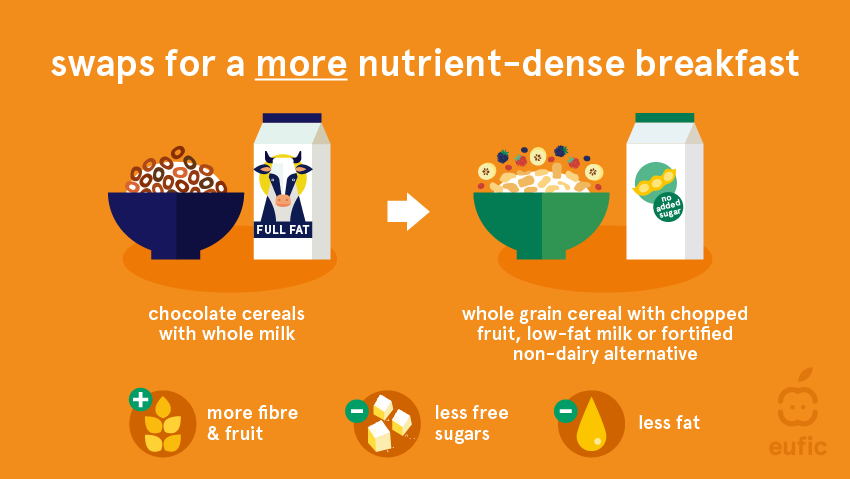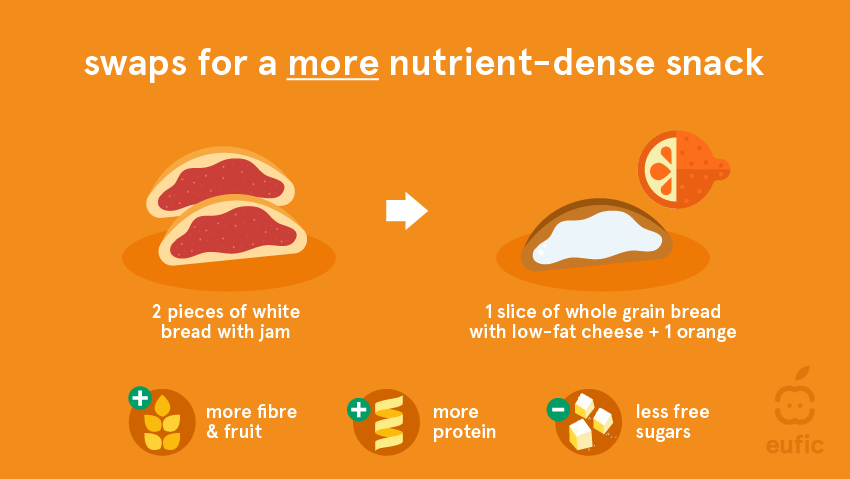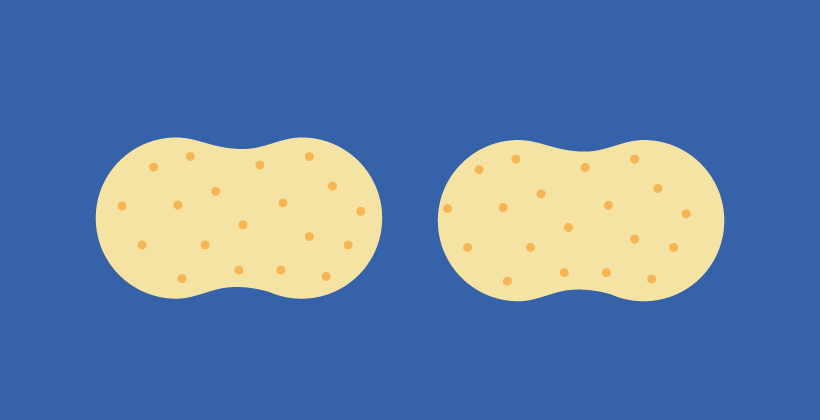What is nutrient density?
Last Updated : 01 November 2021A healthy diet is more than just the right number of calories: our growth, development and health rely on a wide range of nutrients, including vitamins, minerals, protein, fibre and essential fatty acids. In fact, most dietary guidelines encourage us to eat plenty of “nutrient dense” foods to keep a healthy weight and reduce risk of some non-communicable diseases. But what exactly are nutrient dense foods?
At a time when diets can easily provide excessive energy without meeting the nutrient recommendations, understanding the composition of foods - and how the concept of energy content and nutrient density relate to one another in our diets – can be a first step towards improving our diet choices.
In this article we’ll explore in greater detail what is nutrient density, how is it measured and dig into examples of nutrient dense foods and how they fit a healthy and balanced diet.
What is nutrient density and why is it important?
Foods containing a similar calorie content can be very different in terms of the nutrients they provide. Just think of a medium-sized orange and a scoop of vanilla ice-cream. Even if served in portions that provide the same calories, they have very different contents of added sugars, fibre, vitamins and fats.
Even within the same food group there can be differences between the nutritional composition of foods. For example, wholegrain versions of bread, pasta and rice usually contain more fibre, vitamins and minerals than the refined versions. Similarly, fresh cuts of lean meat generally contain less salt and fat than the equivalent portions of processed meats, such as bacon or sausages.
Usually, when a food presents a higher amount of important nutrients per calorie we tend to refer to it as being "more nutrient dense". Key nutrients include those we tend to eat in lower amounts than the recommended, such as some vitamins and minerals (e.g.: calcium, iron, iodine, vitamin D, potassium and folate), protein, unsaturated fats and fibre.1
The advice to eat “nutrient-dense foods” is the basic premise for any healthy diet and you might recognise it from official dietary guidelines. When we base our diets on nutrient-dense foods, we lower the risk of eating too many calories, saturated fat, cholesterol, sugar, salt (sodium) or alcohol and are more likely to keep a healthy weight and decrease risk of certain diseases.2 On the contrary, if we regularly eat foods high in calories, but low in vitamins and minerals, we risk meeting – or even exceeding – our energy needs without getting enough micronutrients or other health-promoting compounds.3 Over time, this increases our risk of nutritional deficiencies and some non-communicable diseases.
Let’s start by understanding the difference between energy and nutrient density.
What is the difference between energy density and nutrient density?
Energy density simply refers to the number of calories contained in 100 g of food, which is the direct measurement of the energy a given food provides. Simply put, high energy-dense foods contain more energy per gram of food, meaning that we’ll eat more calories compared to the same portion of low energy-dense foods.3
The energy density of foods and beverages depends on the amount of water (0 kcal/g), carbohydrates (4 kcal/g), protein (4 kcal/g), fats (9 kcal/g) and alcohol (7 kcal/g) they contain. That’s why energy-dense foods tend to be dry and high in fats (such as biscuits, chips, candy, butter, etc.), whereas less energy-dense foods are usually rich in water and/or fibre (which cannot be fully digested and absorbed by our bodies) such as fruits, vegetables, vegetable soups, etc.3
Contrary to energy density, the definition of nutrient density is less objectively defined. The nutrient density of foods refers to the relative amount of nutrients per calories and is estimated by nutrient profiling methods (we’ll explore them below). Currently, the term “nutrient-dense foods” is used to describe foods that contain a higher amounts of health-promoting nutrients per calorie and are low in saturated fats, added sugars and sodium.2
While the concepts of energy and nutrient density help us understand the composition of foods, it’s important to keep in mind that factors such as the portion sizes or frequency of consumption also influence how many calories and nutrients we get from foods and the overall quality of our diet.
How is the nutrient density of foods calculated?
The nutrient density of foods is determined by what we call nutrient profiling methods. These methods measure how much of specific nutrients foods contain (per 100g, 100 kcal or per serving) and compare them to the dietary recommendations, assigning them a score.4
Nutrient profiling methods aim to rank foods (but also meals or diets) based on their nutrient content, separating nutrient-rich foods from those of lower nutritional value or largely high in energy.5 As a result, they aim to help identify foods that are more likely to be part of a healthy diet and those that may particularly contribute to the excessive consumption of energy, saturated fats, trans fats, sugar or salt.3
In broad terms, foods that provide significant amounts of health-promoting nutrients that are usually not consumed enough – such as fibre, unsaturated fatty acids, potassium, calcium, iron, iodine and vitamin D – score better than foods high in nutrients that we should eat in moderation such as saturated fats, added sugars and sodium (salt).
Nutrient profiling methods can serve many purposes. They are often used to develop front-of-pack labelling schemes which use visual indicators or colour-coded labels to help differentiate products that have a better nutritional balance than others. They can also help inform policy decisions with regards to the restricting the advertisement of less healthy foods to children, regulating nutrition and health claims made on foods or encouraging the industry to reformulate food products.2
However, they still have some limitations. Most notably, different methods take into consideration different nutrients and evaluation criteria. For example, some might consider a food to be more nutrient-dense only if it contains low amounts of nutrients advised to limit (such as added sugars, saturated fat and sodium), while others focus the score on the basis that the food contributes with significant amounts of health-promoting nutrients (like fibre or vitamin D) - despite being relatively high on some of the limiting nutrients.6
What are examples of high nutrient dense foods?
Nutrient-dense foods can be defined as foods that provide vitamins, minerals, and other health-promoting components and have little added sugars, saturated fat, and sodium.
Some examples of nutrient-dense foods include vegetables, fruits, whole grains, seafood, eggs, legumes (such as beans, peas and lentils), unsalted nuts and seeds, fat-free and low-fat dairy products, and lean meats and poultry—when prepared with no or little added sugars, saturated fat, and sodium.2

Still, it’s important to remember that the nutrient density of foods – and their overall nutritional value - can change depending on how they’re prepared, cooked or processed. For example, adding significant amounts of sugar, saturated fats or salt to nutrient-dense foods changes their nutritional balance and might make them less of a good option in some occasions or if consumed regularly. Take a look at some examples of how similar foods can present different nutrient density:


Can a food be both nutrient dense and energy dense?
Yes. While we might be tempted to apply the two concepts in a dichotomous way, it’s not always the case that high energy-dense foods always contain few nutrients or that nutrient-dense foods are necessarily low in calories. Nutrient-dense foods can also be energy-dense, meaning that despite being relatively high in calories, they can provide significant amounts of important nutrients. For example, nuts, seeds, some dairy products and ready-to-eat cereals can have high energy density and an overall high nutritional value.7 The opposite is also true, as some low energy-dense foods, such as diet sodas, might contain almost no calories, but also no nutrients.
As so, it’s not always the case that we should avoid energy-dense foods or equally that we should eat nutrient-dense foods regardless of their energy content. In fact, the concept of nutrient density is better applied to diets rather than individual foods, as overall dietary balance may be achieved through the combination of foods with different nutrient and energy density.
In other words, it’s not necessary for individual foods to match the nutrient profile of a ‘balanced’ diet. Even if a healthy diet that meets nutrient requirements will most likely be mostly made up of nutrient-dense foods it can also include “less healthy” foods (high in saturated fats, free sugars and/or salt), if they’re eaten occasionally and/or in small amounts therefore making up only a small part of the diet.8 Variety and moderation are two key factors to help us find a balance between nutrient- and energy- density.
Increasing the nutrient density of our diets
Small swaps in our everyday meals can help us increase the nutrient density of our diets. Besides prioritising nutrient dense food groups when possible, opting for more nutritionally balanced versions of our frequently consumed products or minding the way we cook foods (for example, by reducing the amount of fats and salt we use) can help us take a step in the right direction.




Key-take away messages
- Energy density measures the calorie content of foods, while nutrient density refers to the nutrient composition of foods.
- Energy-dense foods tend to be dry and high in fats (such as biscuits, chips, candy, butter, etc.), whereas less energy-dense foods are usually rich in water and/or fibre such as fruits, vegetables, vegetable soups, etc.
- Overall, nutrient-dense foods are foods that provide vitamins, minerals, and other health-promoting components and have little added sugars, saturated fat, and sodium.
- Nutrient-dense foods can also be energy-dense, meaning that despite being relatively high in calories, they can provide significant amounts of important nutrients. A few examples include dry beans, nuts, seeds, some dairy products and some ready-to-eat cereals.
- Nutrient profiling methods aim to rank foods (but also meals or diets) based on their nutrient content, separating nutrient-rich foods from those of lower nutritional value or largely high in energy.
- Basing our diets on nutrient-dense foods prevents us from eating too many calories, saturated fat, cholesterol, sugar, salt (sodium), or alcohol and are more likely to keep a healthy weight and decrease risk of certain diseases.
- Examples of nutrient-dense foods include vegetables, fruits, whole grains, seafood, eggs, legumes (such as beans, peas and lentils), unsalted nuts and seeds, fat-free and low-fat dairy products, and lean meats and poultry—when prepared with no or little added sugars, saturated fat, and sodium.
References
- European Food Safety Agency (EFSA) (2008). The setting of nutrient profiles for foods bearing nutrition and health claims pursuant to Article 4 of the Regulation (EC) No 1924/2006.
- U.S. Department of Agriculture and U.S. Department of Health and Human Services (2020). Dietary Guidelines for Americans, 2020-2025. 9th Edition.
- Drewnowski, A (2018). Nutrient density: Addressing the challenge of obesity. British Journal of Nutrition. 120(s1): S8–S14.
- Drewnowski, A (2017). Uses of nutrient profiling to address public health needs: From regulation to reformulation. Proceedings of the Nutrition Society 76(3): 220–229.
- World Health Organisation (WHO) (2010). Nutrient profiling section. Accessed 10 Sep. 2021.
- Lockyear S, et al. (2020). Proceedings of a roundtable event ‘Is communicating the concept of nutrient density important?’. Nutrition Bulletin 45:74-97
- Nicklas TA, Drewnowski A & O’neil CE (2013). The nutrient density approach to healthy eating: Challenges and opportunities. Public Health Nutrition 17(12): 2626–263.
- Scarborough P, Rayner M (2014). When nutrient profiling can (and cannot) be useful. Public Health Nutrition: 17(12), 2637–2640.



